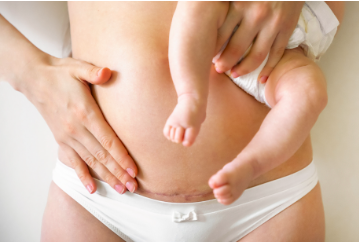
By Chaya Notik, M.Sc., PT

1- The 6-week visit to the Ob-Gyn or midwife is not enough. Most health care providers aren’t assessing for pelvic floor weakness, hypertonicity, organ prolapse nor diastasis recti. If mothers* get back to their regular activities while their bodies are unprepared, they have a higher chance of worsening their preexisting condition or developing a dysfunction, even years later. Therefore, after getting the green light from your doctor or midwife, consult a pelvic floor physiotherapist (PFPT) for a more comprehensive assessment of all the possible tissues affected by a pregnancy or birth experience.
2- Although a positive experience, giving birth is one of the biggest physical ordeals your body undergoes. The pregnancy, the baby’s weight and the hormonal changes all alter the pelvic area that can result in dysfunction. Whether the birth is vaginal or a c-section, there is some degree of tearing or muscle damage. Any other muscle tear would have you visiting a rehabilitation therapist, so it’s only logical that gynecological tears, stresses or problems should have you reacting the same way.
Dr. Arizona Robbins from the television series Grey’s Anatomy sums it nicely!
3- Pelvic floor physiotherapy is not solely for incontinence and it’s not simply about doing Kegels to strengthen the muscles. PFPTs can also help with prolapses, painful intercourse, painful cramps, urgency, changes that come with menopause and more. These dysfunctions can arise for many different reasons. If someone’s dysfunction is caused by tight muscles, Kegels not only won’t help, but they can even make it worse. If the muscles are over recruited, stretching and lengthening is indicated. A PFPT can identify if your pelvic floor presents with overactivity or weakness or both and then works with you to develop a treatment plan.
4- Approximately 60% to 80% of pregnant women have lower back pain (1,2) and this pain is still present around 2 years later in 20% to 40% of women (2,3). Considering the anatomy and the stresses placed on pregnant women as well as the damage caused by birth, taking the pelvic floor muscles into consideration while treating your lower back is valuable and will likely bring you faster and longer lasting improvements. A recent study showed that 95% of the women with lumbopelvic pain had pelvic floor dysfunctions as well (4). Getting your pelvic floor muscles to work more optimally with the rest of your body may be the trick to relieving your lower back pain.
5- After giving birth, many new moms have concerns relating to what their postpartum bodies will feel like and wonder what sexual intercourse after a baby will be like. The questions are there but many are afraid to ask; 68% of adults were concerned about embarrassing the professional and 76% thought no treatment was available for their problems (5). PFPTs have heard many of these questions and yes, there are treatments available. As well, during your sessions, you will learn a lot about yourself and your body in a way that no other professional can address. Pelvic floor physiotherapy can be a way to empower new mothers to prioritize their wellbeing and sexuality as they relearn how to optimally use and enjoy their new bodies.

6- You can come see a PFPT at ANY time. Your muscles can still adapt and recover months or years after giving birth. You can come as soon as you’re cleared for intercourse post partum (or even before to get started with external evaluation and treatment). You can even come while you’re pregnant (if no complications) or during your period. PFPTs understand the normal function of the body and won’t judge or make you feel uncomfortable. In short, people can always benefit from pelvic floor physiotherapy even if it’s not just after a recent birth.
7- Pelvic floor physiotherapy is not practiced by all physiotherapists. Moreover, it is not considered an entry level practice and it is not taught at the university level. Pelvic health professionals are passionate about women’s health and they choose postgraduate training in pelvic floor assessments with internal exams, evaluation and treatment of pelvic floor dysfunctions. Health care providers who don’t do internal exams are unable to get accurate information about your internal tissues and any possible dysfunctions. PFPTs are the professionals who can!
8 – Most new mothers are told to do Kegels by their doctor, friends, the internet, etc. However, our clients are saying “I am not sure if I am doing them right” or “I don’t know if they are effective”. Research found that only about half of the women are doing Kegels properly and 25% of women actually performed a technique that could potentially promote incontinence (6). Therefore, simple instructions given by non-specialized health care providers, even if they are physios, are often not enough for people about to start a Kegel exercise program and a PFPT is the perfect person to make sure you are doing it right.
9- Pelvic floor physio clinics are sometimes baby and child friendly. We understand that many places aren’t and that can be a reason for a new mom to procrastinate making an appointment. Let us know that you are coming with a stroller and you can come in through our stroller-friendly entryway. We have a room specifically for moms and their children where one can breastfeed or play while waiting. We even have a rocking chair… who doesn’t love a rocking chair?!

Elle Santé, Nuvo Physio
10- Pelvic floor physiotherapy is covered under most insurance companies just as traditional orthopedic physiotherapy is. Some insurance providers require a prescription for any sort of therapy, so if you are unsure, just call to be certain. Even if you don’t have the benefits, a few sessions of pelvic floor physio can significantly reduce your symptoms. Additionally, looking at expenses related to a dysfunction like incontinence, for example, women spend $900-$2100 annually on incontinence routine care and products (7,8). Hence, effective incontinence treatment, not simply managing the symptoms, may be economically beneficial as well as improve quality of life in the long run.
Contact us or make an appointment!
*We acknowledge that people of any gender can give birth. For the purposes of this article, the term “mother” and female pronouns will be used for people who give birth.
References :
1- Liddle, S. D., & Pennick, V. (2015). Interventions for preventing and treating low‐back and pelvic pain during pregnancy. The Cochrane Library. doi: 10.1002/14651858.CD001139.pub4.
2- Thorell, E., & Kristiansson, P. (2012). Pregnancy related back pain, is it related to aerobic fitness? A longitudinal cohort study. BMC pregnancy and childbirth, 12(1), 30.
3- To WWK, Wong MWN. Factors associated with back pain symptoms in pregnancy and the persistence of pain 2 years after pregnancy. Acta Obstet Gynecol Scand. 2003;82:1086–91. https://doi.org/10.1046/j.1600-0412.2003.00235.x
4-Dufour, S., Vandyken, B., Forget, M. J., & Vandyken, C. (2018). Association between lumbopelvic pain and pelvic floor dysfunction in women: A cross sectional study. Musculoskeletal Science and Practice, 34, 47-53. Doi: https://doi.org/10.1016/j.msksp.2017.12.001
5-Marwick, C. (1999). Survey Says Patients Expect Little Physician Help on Sex. JAMA, 281(23). doi:10.1001/jama.281.23.2171c
6- Bump, R. C., Hurt, W.G., J. Fantl, J.A., & Wyman, J.F. (1991). Assessment of Kegel pelvic muscle exercise performance after brief verbal instruction. American Journal of Obstetrics & Gynecology 165;2, 322-329. doi: https://doi.org/10.1016/0002-9378(91)90085-6
7- Subak, L. L., Brown, J. S., Kraus, S. R., Brubaker, L., Lin, F., Richter, H. E., … & Diagnostic Aspects of Incontinence Study (DAISy) Group. (2006). The “costs” of urinary incontinence for women. Obstetrics and gynecology, 107(4), 908. Doi: 10.1097/01.AOG.0000206213.48334.09
8- The Canadian Continence Foundation (2014). The impact of incontinence in Canada – A briefing document for policy-makers. Report prepared by the Cameron Institute. Retrived from http://www.canadiancontinence.ca/pdfs/en-impact-of-incontinence-in-canada-2014.pdf





